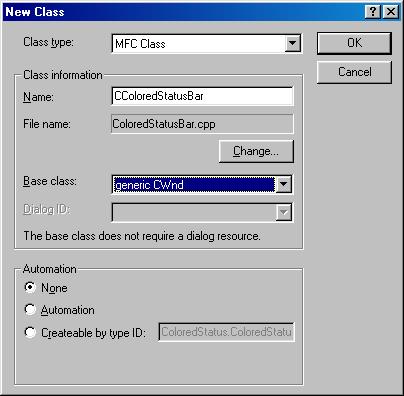



///////////////////////////////////////////////////////////////////////////// // CColoredStatusBar window class CColoredStatusBar : public CStatusBar { // Construction |
BEGIN_MESSAGE_MAP(CColoredStatusBar, CStatusBar) //{{AFX_MSG_MAP(CColoredStatusBar) // NOTE - the ClassWizard will add and remove mapping macros here. //}}AFX_MSG_MAP END_MESSAGE_MAP() |
#include "ColoredStatusBar.h" class CMainFrame : public CMDIFrameWnd { DECLARE_DYNAMIC(CMainFrame) public: CMainFrame(); protected: // control bar embedded members CColoredStatusBar m_wndStatusBar; |
public: CString m_Text; |
| Hello World ! |
protected: void DrawColoredString (CDC& dc,const char* pszTxt); // Overrides // ClassWizard generated virtual function overrides //{{AFX_VIRTUAL(CColoredStatusBar) void DrawItem(LPDRAWITEMSTRUCT lpDrawItemStruct); //}}AFX_VIRTUAL |
void CColoredStatusBar::DrawItem(LPDRAWITEMSTRUCT lpDrawItemStruct) { // Attach to a CDC object CDC dc; dc.Attach(lpDrawItemStruct->hDC); dc.SetBkMode(TRANSPARENT); // Get the pane rectangle and calculate text coordinates CRect rect(&lpDrawItemStruct->rcItem); if(lpDrawItemStruct->itemID == 0) { if(!m_Text.IsEmpty()) { dc.SetTextAlign(TA_UPDATECP); dc.MoveTo(rect.left+2, rect.top); dc.SetTextColor(RGB(0, 0, 0)); DrawColoredString(dc,m_Text); dc.SetTextAlign(TA_NOUPDATECP); } } // Detach from the CDC object, otherwise the hDC will be // destroyed when the CDC object goes out of scope dc.Detach(); } // void CColoredStatusBar::DrawColoredString(CDC& dc,const char* pszTxt) { if(!pszTxt) return; char* pszInk = strstr(pszTxt,"$INK"); if(pszInk) *pszInk = 0; dc.TextOut(0,0,pszTxt); // substring before $INK if(!pszInk) return; pszInk += strlen("$INK"); char* pszEnd = strchr(pszInk,'$'); if(!pszEnd) return; // error *pszEnd = 0; if(0 == strcmp(pszInk,"black")) dc.SetTextColor(RGB( 0, 0, 0)); if(0 == strcmp(pszInk,"blue")) dc.SetTextColor(RGB( 0, 0,255)); DrawColoredString(dc,pszEnd+1); } |
void CMainFrame::SetHelpText(const CString& Text) { m_wndStatusBar.m_Text = Text; // Change 1st pane style to make it Owner-drawn m_wndStatusBar.GetStatusBarCtrl().SetText("", 0, SBT_OWNERDRAW); } |